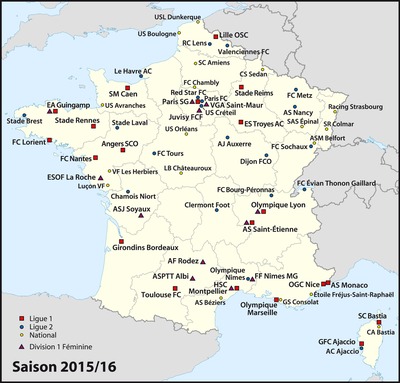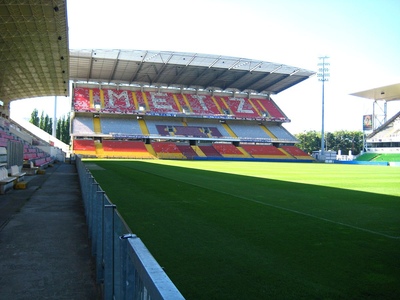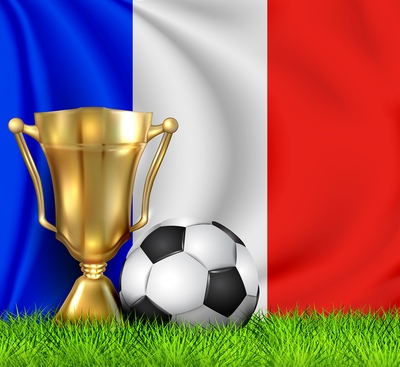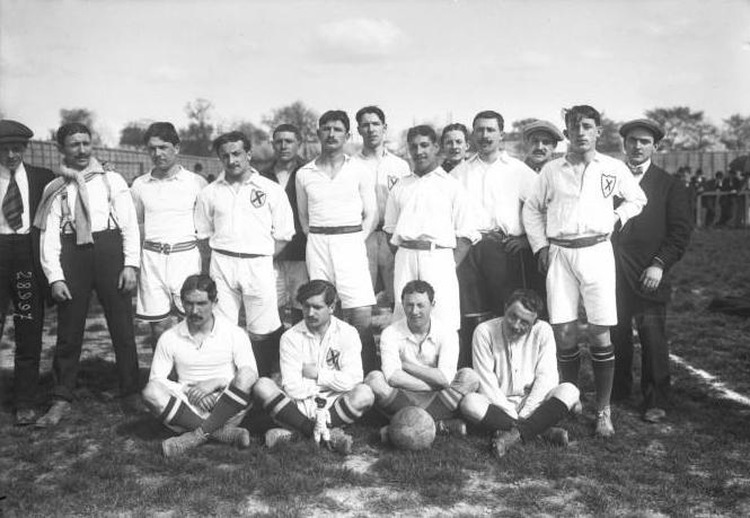Ligue 1 Stadiums & Stats

Known as National when it was first conceived in 1932, the top-tier of French football was renamed Division 1 after just a year of its existence.
In 2002 it was re-branded once more as Ligue 1 and has kept that name ever since.
Alongside Ligue 2 it is part of the Ligue de Football Professionnel, France’s professional league system for association football clubs.
Here we look at the types of stadiums you’ll find in the league, a bit of information about it’s history and tell you all about the league itself.
As France’s premier football league it’s fair to say that there’s a reasonable about that we need to tell you.
Stadium Stats
| Stadium | Year Opened | Capacity | Ave Attendance | Record Attendance | Record Attendance Match |
|---|---|---|---|---|---|
|
Allianz Riviera
OGC Nice |
2013 | 36178 | 22949 | 35596 | OGC Nice v Saint-Etienne 2016 |
|
Parc des Princes
Paris Saint-Germain |
1972 | 47929 | 46930 | 49575 | PSG v Waterschei (1983) |
|
Parc Olympique Lyonnais
Olympique Lyonnais |
2016 | 59186 | 56506 | Lyon v Marseille (2016) | |
|
Stade Bollaert-Delelis
RC Lens |
1933 | 38058 | 28996 | 48912 | Lens v Marseille (1992) |
|
Stade Geoffroy-Guichard
AS Saint-Étienne |
1931 | 41965 | 25803 | 48842 | Saint-Etienne v Lens (1987) |
|
Stade Louis II
AS Monaco |
1985 | 16360 | 11619 | 18523 | Monaco v Chelsea (2004) |
|
Stade Pierre-Mauroy
Lille OSC Métropole |
2012 | 50186 | 29487 | 48960 | Lille v PSG (2014) |
|
Stade Velodrome
Olympique de Marseille |
1937 | 67394 | 47057 | 65252 | Marseille v PSG (2017) |
|
Stadium Municipal de Toulouse
Toulouse |
1937 | 33151 | 17068 | 39450 | US Carmaux vs Stadoceste Tarbais, rugby union, 1951 |
Team Stats
| Team | Year Founded | Nickname | Team Owner |
|---|---|---|---|
| AS Monaco | 1924 | Les Rouges et Blancs | Monaco Sport Investment Ltd, House of Grimaldi |
| AS Saint-Étienne | 1919 | Les Verts (The Greens), Sainté ASSE | Bernard Caiazzo, Roland Romeyer |
| Lille OSC Métropole | 1944 | Les Dogues (The Great Danes) | Merlyn Partners SCSp |
| OGC Nice | 1904 | Les Aiglons (The Eaglets), Le Gym | International Investor Group, Jean-Pierre Rivère |
| Olympique de Marseille | 1899 | Les Phocéens, L'OM, Les Olympiens | Frank McCourt |
| Olympique Lyonnais | 1899 | Les Gones (The Kids) | OL Groupe |
| Paris Saint-Germain | 1970 | Les Rouge-et-Bleu (The Red and Blue) Les Parisiens (The Parisians) | Qatar Sports Investments |
| RC Lens | 1906 | Sang et Or (Blood and Gold) | Amber Capital LP |
| Toulouse | 1970 | Le Téfécé, Le Pitchouns, Le Violets | RedBird Capital Partners |
Ligue 1 Stadiums
 Ligue 1 offers an interesting and eclectic mix of stadiums, with over half of them having modern, bowl-style designs that allow for a better atmosphere and increased capacity. A number of the grounds were either upgraded or built as new in advance of Euro 2016, when France held the European Championships for the third time in the country’s history.
Ligue 1 offers an interesting and eclectic mix of stadiums, with over half of them having modern, bowl-style designs that allow for a better atmosphere and increased capacity. A number of the grounds were either upgraded or built as new in advance of Euro 2016, when France held the European Championships for the third time in the country’s history.
Whilst some of them have been brought up to date because of the Euros, some of them remain… interesting. That’s not to say that they’re not very good or are somehow inferior, it’s just that they maintain the more ‘English Style’ design that clubs with stadiums built recently have left behind. That design allows for a separate stand on each side of the pitch, as opposed to continuous seating that surrounds the entire area of the ground.
As well as grounds being redeveloped ahead of Euro 2016, the other main reason that some of the grounds are so different from each other is that, to put it simply, some clubs are richer than others and can therefore invest more in the development of their grounds. This can be because of historical reasons or it could be because the club with less money has only recently been promoted to Ligue 1 from Ligue 2 and hasn’t had time establish itself in France’s top-flight. Whatever the reason one thing is for sure: A trip around France’s football grounds will give you a taste of the new, the old and the unique.
About The League
 As is the case with the majority of leagues in Europe and, indeed, across the world, Ligue 1 operates on a system of relegation to Ligue 2 as well as promotion from that division to the top-flight. Also like other leagues, the French system works by having the twenty teams in the league play each other twice; once at home and once away for a total of 38 games each. Three points are awarded for a win, one for a draw and, as in life, the loser gets nothing.
As is the case with the majority of leagues in Europe and, indeed, across the world, Ligue 1 operates on a system of relegation to Ligue 2 as well as promotion from that division to the top-flight. Also like other leagues, the French system works by having the twenty teams in the league play each other twice; once at home and once away for a total of 38 games each. Three points are awarded for a win, one for a draw and, as in life, the loser gets nothing.
The French season runs from August until May. Unlike in England, however, games are suspended for a winter break between the last weekend before Christmas and the second week of January, giving players time to recover from their pre-festive exertions and giving clubs time to re-group. Games are typically played on a Saturday or Sunday, though midweek games are becoming more and more common.
Ligue 1 is considered to be one of the best leagues in the world. Alongside La Liga in Spain, the Bundesliga in Germany, Serie A in Italy and England’s own Premier League, it is in the top bracket of association football leagues in Europe that other continents around the globe try to imitate. Since the end of the 2006-2007 season the winner of Ligue 1 has been presented with the trophy, called ‘L’Hexagoal’.
Ligue 1 History
L’histoire de la Ligue 1 est un riche et intéressant. Ha, only joking. Bet we had worried there! Unless you’re fluent in French, in which case don’t be so smug. The history of Ligue 1 is a rich and interesting one, with France having no professional football league prior to its formation. It wasn’t until July 1930 that the National Council of the French Football Federation voted, by a majority of 128-20, to allow the nation of baguettes, red wine and mimes to support professionalism in the game.
Even then it took another two years for professionalism in French football to be officially implemented. The first ever professional league in France was limited to twenty teams, with clubs having to pass certain criteria before they could participate in the competition. They needed to be able to balance their finances through revenue, they needed to have had positive results in the past, and they also had to be able to recruit at least eight professional players; criteria that it feels as though not all Premier League clubs are able to match today.

The league wasn’t always set-up in the now standard round robin format. In its inaugural season saw the twenty teams that took part in it split into two groups of ten, with the winners from each group then facing each other in a final at a neutral venue. Even that didn’t go all that smoothly. Antibes were the official winners of Group B and should have played Olympique Lillois, the winners of Group A, in the final. They were suspected of bribery by the French Football Federation, however, and were disqualified. Instead the Group B runners-up, Cannes, appeared in the league’s first ever final and lost 4-3.
Nowadays things are much simpler in the French league. It follows a similar process to the other major leagues in Europe and teams play each other twice before being ranked according to the amount of points they’ve been able to notch up at the end of the season. The top two teams qualify for the Champions League group stage automatically, whilst the third placed team enters the competition in the qualifying rounds. The bottom two teams are relegated from Ligue 1, with the top two teams in Ligue 2 replacing them.
Previously a more convoluted relegation/promotion system was in place, with the bottom two teams relegated automatically and the top two from Ligue 2 promoted, whilst third-lowest team playing against the winner of the Ligue 2 play-offs to decide who would get the third spot in Ligue 1. Thankfully that has long since been abandoned, mainly because no one understood what was going on.
